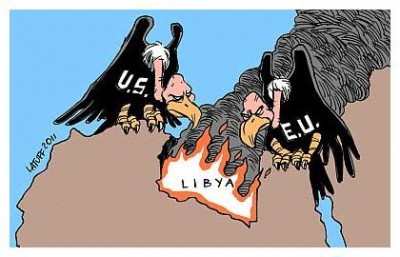NATO Demolishes the Libyan State
The 70 Years of NATO: From War to War

The Following text is Section 6 of
The 70 Years of NATO: From War to War,
by the Italian Committee No War No NATO
*
Documentation presented at the International Conference on the 70th Anniversary of NATO, Florence, April 7, 2019
In the course of the next two weeks, Global Research will publish the 16 sections of this important document, which will also be available as an E-book.
*
Contents
1. NATO is born from the Bomb
2. In the post-Cold War, NATO is renewed
3. NATO demolishes the Yugoslav state
4. NATO expands eastward to Russia
5. US and NATO attack Afghanistan and Iraq
6. NATO demolishes the Libyan state
7. The US/NATO war to demolish Syria
8. Israel and the Emirates in NATO
9. The US/NATO orchestration of the coup in Ukraine
10. US/NATO escalation in Europe
11. Italy, the aircraft carrier on the war front
12. US and NATO reject the UN treaty and deploy new nuclear weapons in Europe
13. US and NATO sink the INF Treaty
14. The Western American Empire plays the war card
15. The US/NATO planetary war system
16. Exiting the war system of NATO
***
1. Multiple factors make Libya important in the eyes of the United States and the European powers. It has the largest oil reserves in Africa, precious for its high quality and low cost of extraction, and large reserves of natural gas. On these, the Libyan state maintains strong control, leaving limited profit margins to US and European companies. In addition to black gold, Libya has white gold: the immense reserve of fossil water from the Nubian aquifer, which extends under Libya, Egypt, Sudan and Chad. Relevant are the sovereign funds, the capital that the Libyan state has invested abroad, in particular to provide Africa with its own financial bodies and its own currency.
2. On the eve of the 2011 war, the United States and the European powers “froze”, or seized, the Libyan sovereign funds, delivering a mortal blow to the entire project. The emails of Hillary Clinton (Secretary of State of the Obama administration in 2011), which came to light later, confirmed the real purpose of the war: to block Gaddafi’s plan to use Libyan sovereign funds to create autonomous financial bodies of the African Union and an African currency as an alternative to the dollar and the CFA franc (the currency that 14 African countries, ex-French colonies are forced to use). It was Clinton – the New York Times would later document – who had President Obama sign “a document authorizing a covert operation in Libya and the supply of weapons to the rebels”.
3. Tribal sectors hostile to the government of Tripoli and Islamic groups that had until a few months before been defined as terrorists were financed and armed. At the same time special forces infiltrated Libya, including thousands of easily disguised Qatari commandos. The entire operation was led by the United States, first through the African Command, then through NATO under US command.
4. On 19 March 2011, Libya’s air-sea bombing began. In seven months, US/NATO air forces carried out 30,000 missions, of which 10,000 were attacks involving the use of over 40,000 bombs and missiles. Italy participated in this war using its military bases and forces and tearing up the Treaty of Friendship, Partnership and Cooperation between the two countries. For the war on Libya, Italy made seven air bases (Trapani, Gioia del Colle, Sigonella, Decimomannu, Aviano, Amendola and Pantelleria) available to the US/NATO forces, providing technical assistance and supplies. The Italian Air Force participated in the war by carrying out over a thousand missions, and the Italian Navy engaged on several fronts.
5. With the US/NATO war of 2011, the Libyan state was demolished and Gaddafi himself assassinated. That State was demolished which, on the southern shore of the Mediterranean facing Italy, maintained “high levels of economic growth” (as the World Bank itself documented in 2010), recording “high indicators of human development” including universal access to primary and secondary education with 46% of the population at university level. Despite the disparities, the standard of living of the Libyan population was considerably higher than that of other African countries. This was evidenced by the fact that over two million immigrants, mostly Africans, found work in Libya.
6. Sub-Saharan African immigrants were also affected by the war, who, persecuted on charges of collaborating with Gaddafi, were imprisoned or forced to flee. Many, driven by desperation, attempted the crossing of the Mediterranean towards Europe. Those who lost their lives were also victims of the war in which NATO demolished the Libyan state.
*
Sections 7-16 of the 70 Years of NATO, From War to War, forthcoming on Global Research
This text was translated from the Italian document which was distributed to participants at the April 7 Conference. It does not include sources and references.
Note to readers: please click the share buttons below. Forward this article to your email lists. Crosspost on your blog site, internet forums. etc.

